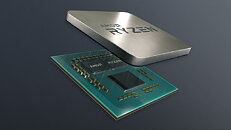Thursday, March 18th 2021

AMD's Next-Generation Van Gogh APU Shows Up with Quad-Channel DDR5 Memory Support
AMD is slowly preparing to launch its next-generation client-oriented accelerated processing unit (APU), which is AMD's way of denoting a CPU+GPU combination. The future design is codenamed after Van Gogh, showing AMD's continuous use of historic names for their products. The APU is believed to be a design similar to the one found in the SoC of the latest PlayStation 5 and Xbox Series X/S consoles. That means that there are Zen 2 cores present along with the latest RDNA 2 graphics, side by side in the same processor. Today, one of AMD's engineers posted a boot log of the quad-core Van Gogh APU engineering sample, showing some very interesting information.
The boot log contains information about the memory type used in the APU. In the logs, we see a part that says "[drm] RAM width 256bits DDR5", which means that the APU has an interface for the DDR5 memory and it is 256-bit wide, which represents a quad-channel memory configuration. Such a wide memory bus is typically used for applications that need lots of bandwidth. Given that Van Gogh uses RDNA 2 graphics, the company needs a sufficient memory bandwidth to keep the GPU from starving for data. While we don't have much more information about it, we can expect to hear greater details soon.
Source:
FreeDesktop Lists
The boot log contains information about the memory type used in the APU. In the logs, we see a part that says "[drm] RAM width 256bits DDR5", which means that the APU has an interface for the DDR5 memory and it is 256-bit wide, which represents a quad-channel memory configuration. Such a wide memory bus is typically used for applications that need lots of bandwidth. Given that Van Gogh uses RDNA 2 graphics, the company needs a sufficient memory bandwidth to keep the GPU from starving for data. While we don't have much more information about it, we can expect to hear greater details soon.

24 Comments on AMD's Next-Generation Van Gogh APU Shows Up with Quad-Channel DDR5 Memory Support
So this might mean that it's just a typical 2 or 4 DIMM slot design.Edit: Actually while the above is correct, it still doesn't explain the 256-bit interface reported by the kernel. That might suggest a 4 DIMM design. How do we call this in DDR5? Quad-? Octo-channel? This is going to get confusing ;)
still, given D5 6400, thats still about 80GB/s, and D5 8400 at just over 100GB/s, that's tailing 1050Ti bandwidth, which is a nice improvement for budget gaming all depending on price. just like when Vega iGPU first came out. Now they are getting a bit slow for anything above esport.
That and current GPU situation -_-; hope Intel pulls out something nice too with their D5 CPUs because I have no idea how much these APUs are gonna cost...
But the interesting question is how do we call 1 DIMM of DDR5? It is technically dual-channel, but historically we've been calling 2 DIMMs that. How many channels will mainstream IMCs have? 4?
So it might be possible that these change lead to a 4 dimm/8 channel/256 bit setup. We would ahve to see altought that for now, your hypothesis of the system not detecting the DDR5 channel properly or just assuming they are 64 bit is the most probable.
The funny (or sad) thing is even with 4 channel, we could still see vendor just slapping 1 DIMM, but now they could i guess call that dual channel. That is going to be a mess for sure...
Wider than 128 bit memory controllers are unlikely, as the minimum memory capacity would be pretty large. No-one makes or has plans to introduce smaller than 16gig sticks. 64gig minimum capacity for nominal memory performance seems excessive for mainstream platforms.
From what I understood from Rambus's site DDR5 can be 1, 2 or 4 rank.
Can a half-DIMM of DDR5 function as single channel tho? ;)
This article suggests that it could be a mobile Xbox APU. If that's true, Zen 2 would make more sense IMO.
www.notebookcheck.net/Microsoft-handheld-Xbox-console-rumors-spring-up-again-as-AMD-Van-Gogh-APU-appears-in-Linux-kernel-code-with-a-potential-graphics-boost.528206.0.html
And yes, it might create some confusion for a few months until people get the grasp of things again, but it’s still better than mislabeling stuff for legacy reasons. Most people just count memory DIMMs anyway.